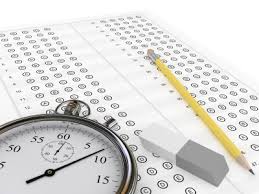 Whether you are pro or anti standardized testing, you or your child are going have to confront them. They are a part of our education system, and since the NCLB (No Child Left Behind) Initiative, their value in our education system has skyrocketed. Whether you’re a third grader prepping for a state wide assessment exam, or a professional gearing up for the GRE, when asked to perform on a standardized test, you are essentially being asked to “think within the box” (or bubble). Standardized tests are a beast of their own: they require not only that you access retained information, but can decode a question, process it, use critical reasoning to find an answer, switch from topic to topic effortlessly, all under pressure to perform.
Whether you are pro or anti standardized testing, you or your child are going have to confront them. They are a part of our education system, and since the NCLB (No Child Left Behind) Initiative, their value in our education system has skyrocketed. Whether you’re a third grader prepping for a state wide assessment exam, or a professional gearing up for the GRE, when asked to perform on a standardized test, you are essentially being asked to “think within the box” (or bubble). Standardized tests are a beast of their own: they require not only that you access retained information, but can decode a question, process it, use critical reasoning to find an answer, switch from topic to topic effortlessly, all under pressure to perform.
Proponents of standardized testing argue that “teaching to the test” is not so terrible, as it keeps teachers on track and committed to making students motivated to excel in a goal-oriented fashion. In this way, “teaching to the test” can also easily identify what areas a student needs to work on in a definitive way. And lastly, performance anxiety is a part of life, one that we will all have to face eventually, and standardized testing is one way for young people to practice excelling under stress. Students can also learn to manage the stress they experience under these conditions rather than let it control the entirety of their scholastic  experiences.
experiences.
On the other hand, detractors of standardized testing argue that test performance is not an accurate, and certainly not holistic measure of learning. NCLB is more about policy making than it is about a commitment to education and the empowerment that comes from learning, thinking critically, the ability to ask rather than answer questions. “Teaching to the test” might have temporary effects in a student’s performance, but is not a reliable way of measuring academic growth. (As an aside, I think within “teaching to the test” there are various methodologies to explore aside from rote learning and regurgitating facts — but that’s another post!) We just have not figured out how to use test-based incentives to improve education (which is the goal of education based policy making). There is also much to be said for the objectivity of standardized test questions (meaning that questions are not in fact objective) and even with appropriate accommodations given to students with learning differences, uniform questions do not address the complexity of learning styles.
Given all the pros and cons of standardized testing, one thing is clear: a test cannot measure some of the most valuable learning skills like empathy, creativity, resourcefulness, integrity, and critical analysis. Testing relies on the notion that there is a right and a wrong answer, and while that may be the case with many situations in life, there isn’t always an absolute truth. Low test scores can damage a student’s self-esteem and create a poor self-image, especially the younger we start mandating tests. However, testing can also build resilience, teach students how to reason under pressure, perform under stress, focus, and complete a task. There’s no easy answer to this debate, but there are solutions on how to approach standardized tests.
- Preparation is key.
- Organization and methodical study habits can be motivational.
- Manage the importance you or your child put on testing.
- Separate how you think about learning and achievement.
If you are seeking accommodations DO NOT WAIT, before filing the appropriate paperwork — whether that means an IEP report or private testing from a neuropsychologist. In order for the Board of Education or private testing board, like the College Board, to grant accommodations (like extra time, having questions read aloud to students, a computer and or scribe) students must have a track record (with the appropriate paper trail) that precedes the test date.





